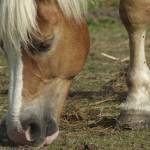Genetic Defect Declining in Belgian Horses

Junctional epidermolysis bullosa, or JEB, is a heritable condition in which a horse lacks a protein that plays an important role in helping skin adhere to the underlying tissues. Affected foals are sometimes born with, or quickly develop, areas that appear to be skinless. These ulcerated areas usually develop first on the foal’s legs in places that touch the ground when the young horse lies down. Because there is no effective treatment or cure, these foals must be put down.
JEB occurs when foals inherit a mutation from both parents. The condition is recessive, so foals that inherit a single copy of the defective gene don’t show the problem, though they can pass it on to their offspring.
Ten years of genetic screening on Belgian horses registered in Canada and the U.S. showed that 12.5% of the 2,554 tested horses carried the mutation. Many Belgian stallions and some mares have been tested, and the number of affected horses is dropping as breeders choose stallions that are negative for the gene. Registries in Canada and the U.S. already require genetic testing for the sires of foals seeking registration, and the Belgian Draft Horse Corporation of America will institute mandatory testing of breeding-age mares in 2015. Horse owners can use untested animals for breeding, but only foals from non-carrier stallions and mares will be eligible for registration. This step should continue the trend toward fewer incidences of JEB within the breed.








